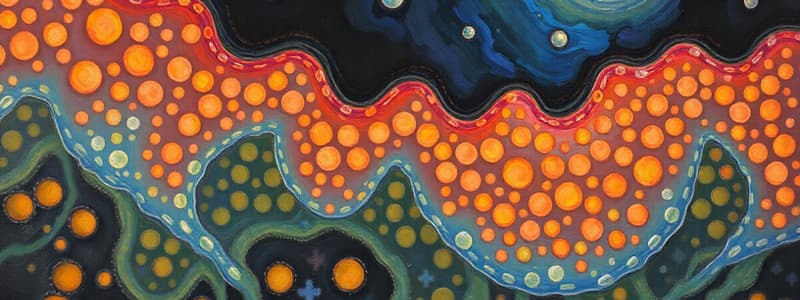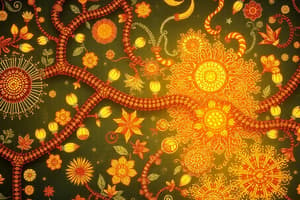Podcast
Questions and Answers
What is the initial process by which proteins enter the endoplasmic reticulum (ER)?
What is the initial process by which proteins enter the endoplasmic reticulum (ER)?
- Co-translational transport (correct)
- Endocytosis
- Constitutive secretion
- Retrograde transport
The Golgi apparatus is a single, unchanging structure within the cell.
The Golgi apparatus is a single, unchanging structure within the cell.
False (B)
What is the function of retrograde transport in the Golgi apparatus?
What is the function of retrograde transport in the Golgi apparatus?
To transport proteins from later to earlier Golgi cisternae.
Proteins are released from the cell in response to an external signal during ______ secretion.
Proteins are released from the cell in response to an external signal during ______ secretion.
Which of the following describes the movement of proteins through the Golgi?
Which of the following describes the movement of proteins through the Golgi?
Endocytosis involves the plasma membrane folding inward to bring materials into the cell.
Endocytosis involves the plasma membrane folding inward to bring materials into the cell.
What role do vesicles play in the endomembrane system?
What role do vesicles play in the endomembrane system?
Match the following processes with their descriptions:
Match the following processes with their descriptions:
Which of the following best describes co-translational transport?
Which of the following best describes co-translational transport?
Constitutive secretion requires an external signal for proteins to be released from the cell.
Constitutive secretion requires an external signal for proteins to be released from the cell.
What is the role of the Golgi apparatus in the endomembrane system?
What is the role of the Golgi apparatus in the endomembrane system?
Proteins destined for degradation are transported to ________ or other organelles.
Proteins destined for degradation are transported to ________ or other organelles.
Match the following organelles with their function in protein transport:
Match the following organelles with their function in protein transport:
What is the fate of proteins that undergo regulated secretion?
What is the fate of proteins that undergo regulated secretion?
Retrograde transport only occurs from the ER to the Golgi.
Retrograde transport only occurs from the ER to the Golgi.
How do vesicles contribute to the interconnectedness of the endomembrane system?
How do vesicles contribute to the interconnectedness of the endomembrane system?
The dynamic nature of biological membranes and the highly organized transport processes occur within a ________ cell.
The dynamic nature of biological membranes and the highly organized transport processes occur within a ________ cell.
What structural feature allows the Golgi apparatus to have distinct compartments?
What structural feature allows the Golgi apparatus to have distinct compartments?
Flashcards
Co-translational transport
Co-translational transport
Process where proteins enter the ER while being synthesized by ribosomes.
ER-to-Golgi transport
ER-to-Golgi transport
Vesicles bud off from the ER to transport proteins to the Golgi apparatus.
Cisternal maturation
Cisternal maturation
Process where Golgi cisternae change composition as proteins pass through.
Constitutive secretion
Constitutive secretion
Signup and view all the flashcards
Regulated secretion
Regulated secretion
Signup and view all the flashcards
Retrograde transport
Retrograde transport
Signup and view all the flashcards
Sorting to lysosomes
Sorting to lysosomes
Signup and view all the flashcards
Endocytosis
Endocytosis
Signup and view all the flashcards
Endoplasmic Reticulum (ER)
Endoplasmic Reticulum (ER)
Signup and view all the flashcards
Golgi Apparatus
Golgi Apparatus
Signup and view all the flashcards
Cisternae
Cisternae
Signup and view all the flashcards
Vesicles
Vesicles
Signup and view all the flashcards
Lysosomes
Lysosomes
Signup and view all the flashcards
Secretory vesicles
Secretory vesicles
Signup and view all the flashcards
Extracellular material
Extracellular material
Signup and view all the flashcards
Cytosol
Cytosol
Signup and view all the flashcards
Biological membranes
Biological membranes
Signup and view all the flashcards
Study Notes
Biomembrane Processes
-
Exterior Cytosol:
-
Regulated secretion occurs through vesicles.
-
Constitutive secretion happens continuously.
-
Plasma Membrane:
-
Endocytosis involves vesicles bringing material into the cell.
-
Endocytic vesicles are sorted with transport vesicles then to lysosomes.
-
Golgi Apparatus:
-
CIS-Golgi network is the starting point.
-
Medial-Golgi, and TRANS-Golgi network follows
-
Vesicles bud and fuse from the Golgi network to ER.
-
Vesicles bud and fuse to form CIS-Golgi, medial-Golgi to trans-Golgi
-
Retrograde Transport:
-
Materials travel from later to earlier Golgi cisternae.
-
Materials travel from Golgi to ER.
-
Sorting occurs in the trans-Golgi
-
Rough ER:
-
Protein synthesis happens on bound ribosomes.
-
Co-translational transport of proteins is into ER membrane.
Studying That Suits You
Use AI to generate personalized quizzes and flashcards to suit your learning preferences.




